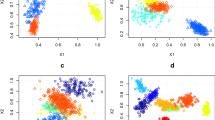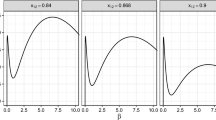Abstract
This paper deals with the concept of sequential order statistics (SOS) for modeling the sequential r-out-of-n: F systems under a conditional proportional hazard rates drawn from a two-parameter Pareto distribution. Maximum likelihood estimates of parameters of interest are investigated based on multiple SOSs. Proposing various priors for the parameters of the assumed model, the Bayes estimates of the parameters of interest are derived and admissibility of obtained estimators is investigated. Due to the lack of explicit expressions for some of the obtained Bayes estimates, Lindley’s approximations are derived. To assess the performance of the obtained estimators, we conducted extensive simulation studies.
Similar content being viewed by others
References
Aban, I.B., Meerschaert, M.M., Panorska, A.K.: Parameter estimation for the truncated pareto distribution. J. Am. Stat. Assoc. 101(473), 270–277 (2006)
Abdel-Aty, Y., Franz, J., Mahmoud, M.A.W.: Bayesian prediction based on generalized order statistics using multiply type-II censoring. Statistics 41(6), 495–504 (2007)
Aki, S., Hirano, K.: Lifetime distribution and estimation problems of consecutive-k-out-of-n: F systems. Ann. Inst. Stat. Math. 48(1), 185–199 (1996)
Ali, M.A.M.: Mousa. Inference and prediction for pareto progressively censored data. J. Stat. Comput. Simul. 71, 163–181 (2001)
Arnold, B.C., Press, S.J.: Bayesian inference for pareto populations. J. Econom. 21, 287–306 (1983)
Arnold, B.C., Press, S.J.: Bayesian estimation and prediction for pareto data. J. Am. Stat. Assoc. 84, 1079–1084 (1989)
Balakrishnan, N., Cramer, E., Kamps, U., Schenk, N.: Progressive type II censored order statistics from exponential distributions statistics. Statistics 35, 537–556 (2001)
Balakrishnan, N., Nevzorov, V.B.: A Primer on Statistical Distributions. Wiley, Hoboken (2003)
Bedbur, S.: Umpu tests based on sequential order statistics. J. Stat. Plan. Inference 140, 2520–2530 (2010)
Berger, J.M., Mandelbrot, B.: A new model for error clustering in telephone circuits. IBM J. 7, 224–236 (1963)
Berger, J.O.: Statistical Decision Theory and Bayesian Analysis, 2ed edn. Springer, New York (1985)
Beutner, E., Kamps, U.: Order restricted statistical inference for scale parameters based on sequential order statistics. J. Stat. Plan. Inference 139, 2963–2969 (2009)
Cramer, E., Kamps, U.: Sequential order statistics and k-out-of-n systems with sequentially adjusted failure rates. Ann. Inst. Stat. Math. 48(3), 535–549 (1996)
Cramer, E., Kamps, U.: Estimation with sequential order statistics from exponential distributions. Ann. Inst. Stat. Math. 53, 307–324 (2001)
Cramer, E., Kamps, U.: Sequential k-out-of-n systems. In: Balakrishnan, N., Rao, C.R. (eds.) Handbook of Statistics: Advances in Reliability, pp. 301–372. Elsevier, Amsterdam (2003). Chap. 12
Cramer, E., Kamps, U.: Marginal distributions of sequential and generalized order statistics. Metrika 58, 293–310 (2003)
Doostparast, M., Akbari, M.G., Balakrishnan, N.: Bayesian analysis for the two-parameter pareto distribution based on record values and times. J. Stat. Comput. Simul. 81(11), 1393–1403 (2011)
Dyer, D.: Structural probability bounds for the strong pareto law (dyer). Canadian Journal of Statistics 9, 71–77 (1981)
Fernandez, A.J.: Bayesian estimation based on trimmed samples from pareto populations. Comput. Stat. Data Anal. 51, 1119–1130 (2006)
Harris, C.M.: The pareto distribution as a queue service discipline. Oper. Res. 16(2), 307–313 (1968)
Howlader, H.A., Hossain, A.M.: Bayesian survival estimation of pareto distribution of the second kind based on failure-censored data. Comput. Stat. Data Anal. 38, 301–314 (2002)
Kamps, U.: A concept of generalized order statistics. J. Stat. Plan. Inference 48, 1–23 (1995)
Lindley, D.V.: Approximate bayesian methods. Trab. Estad. 31, 223–337 (1980)
Madi, M.T., Raqab, M.Z.: Bayesian prediction of temperature records using the pareto model. Environmetrics 15, 701–710 (2004)
Nabe, M., Murata, M., Miyahara, H.: Analysis and modeling of world wide web trac for capacity dimensioning of internet access lines. Perform. Eval. 34, 249–271 (1998)
Nigm, A.M., Hamdy, H.I.: Bayesian prediction bounds for the pareto lifetime model. Commun. Stat. 16, 1761–1772 (1987)
Rizzo, M.L.: New goodness-of-fit tests for pareto distributions. Astin Bull. 39(2), 691–715 (2009)
Royden, H.L.: Real Analysis. A Simon and Schuster Company, New York City (1988)
Rytgaard, M.: Estimation in the pareto distribution. Astin Bull. 20(2), 201–216 (1990)
Schenk, N., Burkschat, M., Cramer, E., Kamps, U.: Bayesian estimation and prediction with multiply type-II censored samples of sequential order statistics from one-and two-parameter exponential distributions. J. Stat. Plan. Inference 141, 1575–1587 (2011)
Soliman, A.A.: Bayesian prediction in a pareto lifetime model with random sample size. Statistician 49(1), 51–62 (2000)
Wu, C., Wu, S., Chan, H.Y.: Mle and the estimated expected test time for pareto distribution under progressive censoring data. Int. J. Inf. Manag. Sci. 15(3), 29–42 (2004)
Wu, S.: Estimation for the two-parameter pareto distribution under progressive censoring with uniform removals. J. Stat. Comput. Simul. 73(2), 125–134 (2003)
Acknowledgements
The authors are grateful to anonymous referees and the Editor in Chief for their useful suggestions and comments on an earlier version of this manuscript, which resulted in a substantial improvement of this manuscript.
Author information
Authors and Affiliations
Corresponding author
Additional information
Communicated by Anton Abdulbasah Kamil.
Appendix
Appendix
To prove admissibility of \({\hat{\beta }}_{1,0,0}\), we show that the conditions of Theorem 13 in [11] (p. 547) hold. Notice that, following Theorem 3.1 of [13], we conclude that \(-\ln T_2 \sim \Gamma (rs, \beta )\). Let consider \(\{\pi _m; m\ge 1\} = \{\Gamma (1/m,1/m); m\ge 1\}\) be a sequence of proper priors for \(\beta \). The Bayes estimate of \(\beta \) under the SEL function is \({\hat{\beta }}_{1,1/m,1/m}=(rs+1/m)/(1/m-\ln T_2)\) which tends to \({\hat{\beta }}_{1,0,0}\) as \(m \rightarrow \infty \). The risk difference of \({\hat{\beta }}_{1,1/m,1/m}\) and \({\hat{\beta }}_{1,0,0}\) is
Notice that \(E\left( -\ln T_2\right) ^{-1}=\beta /(rs-1)\), \(E\left( -\ln T_2\right) ^{-2}=\beta ^2/(rs-1)(rs-2)\), \(E\left( m^{-1}-\ln T_2\right) ^{-1}=\beta ^{rs}e^{\beta m^{-1}} \Phi _1(rs,1,\beta ,m^{-1})/\Gamma (rs)\) and \(E\left( m^{-1}-\ln T_2\right) ^{-2}=\beta ^{rs}e^{\beta /m} \Phi _1(rs,2,\beta ,1/m)/\Gamma (rs)\) where \(\Phi _1(n,,k,h,\eta )=\int _{\eta }^{\infty } \frac{(x-\eta )^{n-1}}{x^k}e^{-h x}\, dx\).
Substituting these values into (36) and using the monotone convergence theorem [28] at p 87, \(D_{m}\) tends to zero as \(m\rightarrow \infty \). From (36), Condition (c) of Theorem 13 in [11] (p. 547) satisfies by taking expectation w.r.t. the proper prior \(\pi _m\). The estimator \({\hat{\beta }}_{1,1/m,1/m}\) is the unique Bayes estimate under the SEL function w.r.t. the proper prior \(\pi _m\), and hence, the Bayes risk \(r({\hat{\beta }}_{1,1/m,1/m},\beta )=E^{\pi _m}[R({\hat{\beta }}_{1,1/m,1/m},\beta )]\) is finite. This implies that the Bayes risk of the estimator \({\hat{\beta }}_{1,0,0}\) is finite, and this fulfill of Condition (a) of Theorem 13 in [11] (p. 547). On the other hand, any nondegenerate convex subset \(C\subseteq \Theta =[0,\infty )\) is an interval, say [a, b], then it is sufficient to show that, there exist a \(K>0\) and integer M such that, for \(m\ge M\), \(\int _a^b \pi _m(\beta ) d\beta \ge K\). Since the function \((1/m)^{1/m}\) is increasing in m for \(m\ge 4\), we have
where \(A=\frac{(1/4)^{1/4}}{\Gamma (1/4)}e^{-b^*/4}\), \(b^*=\min (a+1,b)\) and \(a>0\). For \(b^*<1\), it is easy to see that \(m\,(b^*)^{1/m}\) is an increasing function w.r.t. m and hence \(A\,m\,(b^*)^{1/m}\ge 4A\,(b^*)^{1/4}=K_1\). For \(b^*\ge 1\), \(A\,m\,(b^*)^{1/m}\ge 4A=K_2 \ge K_1\). Assuming \(K= K_1\), Condition (b) of Theorem 13 in [11] (p. 547).
Rights and permissions
About this article
Cite this article
Esmailian, M., Doostparast, M. Estimates Based on Sequential Order Statistics with the Two-Parameter Pareto Distribution. Bull. Malays. Math. Sci. Soc. 42, 2897–2914 (2019). https://doi.org/10.1007/s40840-018-0637-6
Received:
Revised:
Published:
Issue Date:
DOI: https://doi.org/10.1007/s40840-018-0637-6




